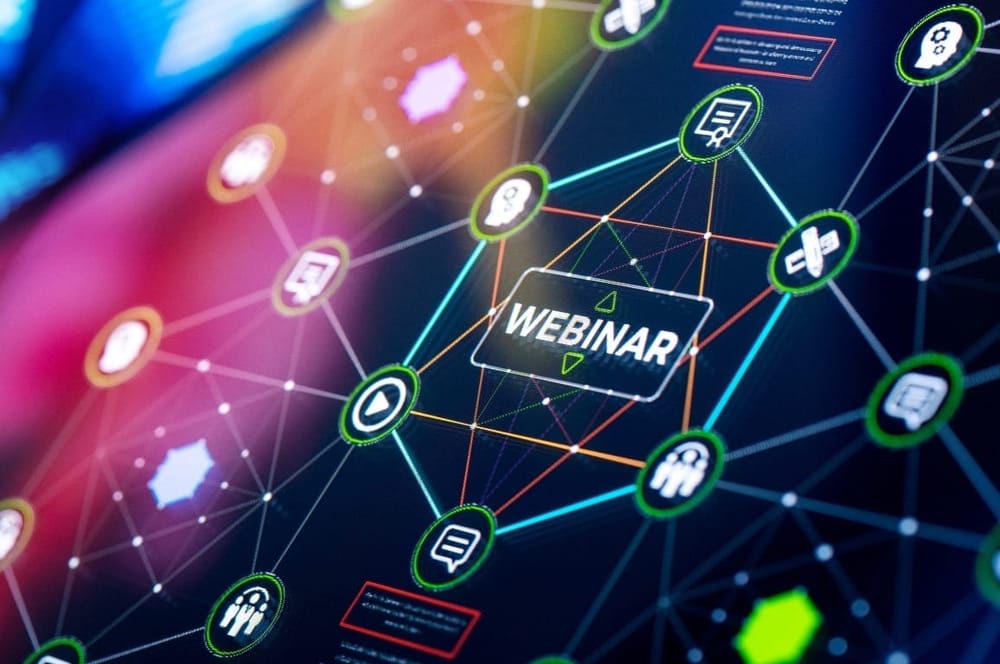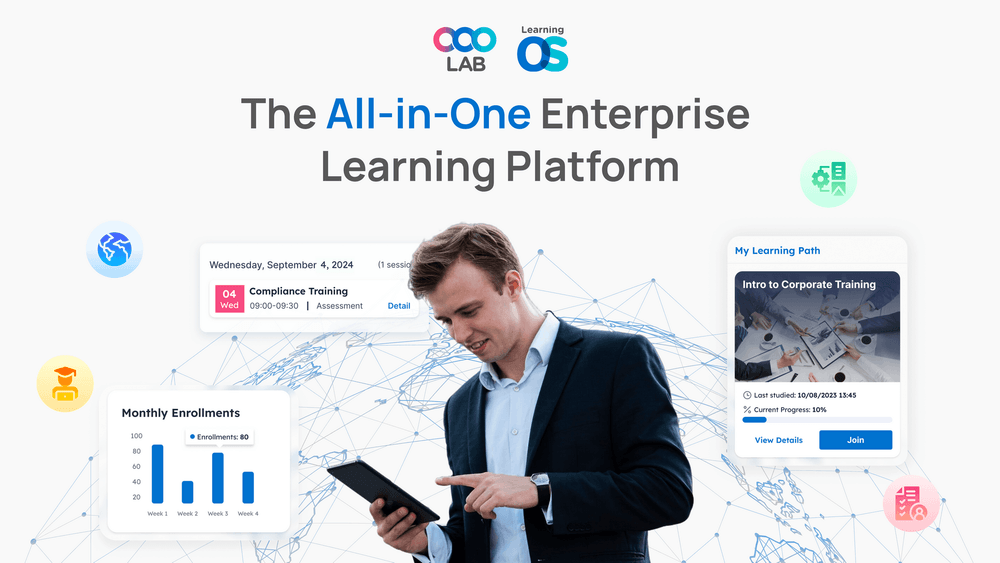

In today’s fast-evolving workplace, an Enterprise LMS for Professional Development isn’t just a tool for training—it’s a strategic asset that supports both (1) employee growth and (2) organizational agility.
From the learner's perspective, adult professionals thrive on autonomy, relevance, and goal-oriented learning—principles that must be built into any effective LMS experience.
At the same time, businesses demand solutions that align with strategic goals, close skill gaps, and deliver measurable ROI.
This blog explores the best features of a professional development LMS that drive both employee development and organization agility.
A Professional Development LMS is a learning management system designed to support continuous employee growth by offering personalized learning paths, skill-building opportunities, and tools for career advancement.
It aligns individual learning goals with business objectives, helping organizations nurture talent, boost engagement, and stay competitive in a rapidly changing workplace.
From the employee’s perspective, 92% of participants in LinkedIn Workplace Learning Report 2025 admit that workplace learning increases their engagement.
For businesses, the value is equally clear: McKinsey reports that companies that realign training with evolving skill needs see:
a 50% increase in employee engagement
a 40% boost in productivity
a 50% reduction in training costs
This makes an enterprise-ready LMS not just a tool, but a strategic asset for future-ready workforce development.

>>> Read more: How a Professional Development LMS Supports Career Growth
>>> Read more: How to Measure ROI from Your Enterprise LMS
>>> Read more: Transforming Learning & Development: Discover LearningOS
An effective Learning Management System (LMS) demonstrates seamless alignment of training with business goals. It offers tools that streamline planning, execution, and continuous assessment of development initiatives.
More importantly, as eLearning Industry and Duke University has highlighted, professional developments should commence from the moment a new employee joins the organization and continue through regular, structured reviews, which adds a heavy workload on L&D team, trainers, and managers.
Therefore, an effective LMS must be able to record, track, and provide advanced analytics on employee’s learning to assist trainers and organizations, enabling regular and throughout reviews. It assists them to make amendments to align training with organizational objectives.
Career planning tools in professional development are systems or softwares that help HR teams, managers, and employees to:
(1) set career goals
(2) map development paths
(3) align learning with business strategy
(4) track progress over time
Popular examples include Workday, SAP SuccessFactors, or Cornerstone OnDemand.
An effective LMS for employee development integrating seamlessly with these planning tools can:
Ensure training programs are aligned with long-term business objectives.
Help employees connect learning activities to defined career milestones
Enable real-time adjustments, as organizational needs and priorities evolve
Facilitate internal mobility
Support proactive succession planning
>>> Read more: Why is employee upskilling non-negotiable for business success
>>> Read more: Building Confidence in Your Sales Team Through Training and Development
This feature of an effective professional development LMS empowers learners to take ownership of their development but also simplifies the training strategy for HR teams, in particularly:
Learners can follow structured pathways based on their current roles, skill levels, and long-term career objectives.
Administrators can align these paths with evolving business priorities, ensuring learning remains relevant as teams grow.
Modules can include (1) role-based courses, (2) cross-functional skill-building, and (3) leadership development—providing a scalable approach to professional growth.
In addition, an effective LMS can (1) auto-customize the learning paths when it is integrated with career planning tools like Cornerstone OnDemand or SAP SuccessFactors or based on job roles. It also allows (2) manual customization. All in all, it is designed to support succession planning and internal mobility.
>>> Read more: Customization Options for Enterprise LMS
>>> Read more: Employee Engagement Strategies for Your Enterprise LMS
>>> Read more: Transforming Learning & Development: Discover LearningOS
An effective LMS for employee growth (1) issues badges and certificates automatically upon course completion, and (2) integrates them into employee profiles or performance systems.
 This feature enhances learners’ motivation and their accountability while giving organizations measurable benchmarks for professional growth:
This feature enhances learners’ motivation and their accountability while giving organizations measurable benchmarks for professional growth:
Learners gain formal recognition through certificates or digital badges, after completing structured learning modules or assessments.
HR teams can align certifications with internal job roles or external industry standards, helping to identify qualified talent within the organization.
These systems support both (1) short-term skill acquisition and (2) long-term development planning, reinforcing a culture of achievement and learning.
>>> Read more: Top Online Courses and Certifications to Offer in Your Professional Development LMS
>>> Read more: How to Foster a Continuous Learning Culture with an LMS
 An effective LMS for employee development fosters a culture of shared learning by offering built-in collaboration features that enhance engagement and retention across teams:
An effective LMS for employee development fosters a culture of shared learning by offering built-in collaboration features that enhance engagement and retention across teams:
Learners can participate in (1) discussion forums, (2) peer reviews, or (3) group projects—promoting active knowledge exchange and social learning.
HR teams and trainers can create (4) communities of practice, (5) mentorship circles, or (6) cohort-based learning spaces to deepen team alignment and knowledge sharing.
(7) Real-time chat, (8) comment threads, and (9) content co-creation tools (like shared whiteboards or wikis) keep learning interactive and dynamic, especially with geographically dispersed teams.
These tools encourage collaborative learning and reinforce knowledge retention—making development more impactful than solitary course completion.
Peer-to-Peer Learning Drives Sales Enablement Success According to Forrester’s Sales and Customer-Facing Roles Survey, peer-to-peer coaching and knowledge sharing are among the top three preferred training methods for high-performing reps. These interactions help revenue teams build competence and confidence faster—enabling them to overcome common development barriers and continuously share best practices. Peer learning isn’t just a support tool—it’s a go-to-market differentiator. |
A Professional Development LMS equipped with analytics features to monitor development progress and align learning outcomes with business goals:
HR teams gain visibility into learner engagement, course completion rates, and skill acquisition through real-time dashboards and automated reports.
Managers can track individual and team progress toward specific goals, identifying top performers or those needing additional support.
Learners can review their own learning data—such as time spent on modules, assessment performance, or certifications earned—to stay accountable and make informed choices.
These insights transform training from a checkbox activity into a measurable, results-driven component of workforce development platforms.
An effective LMS for professional training goes beyond static modules by offering engaging, interactive content that supports adult learners' preferences for autonomy and practical application.
Learners benefit from (1) multimedia formats such as videos, quizzes, simulations, drag-and-drop exercises, and (2) scenario-based learning that reflect real workplace challenges.
Trainers can design (3) branching scenarios or (4) microlearning segments to enhance retention and make complex concepts easier to understand.
The platform can track (5) interaction metrics—like click rates or quiz scores—to adjust (6) content delivery based on learner behavior.
Interactive delivery makes learning more relevant, memorable, and aligned with the fast-paced expectations of modern enterprise environments.
This feature of a talent development LMS supports identifying areas where employees need further development and align learning with those needs in real time.
The LMS can (1) evaluate employees’ current competencies through pre-assessments, performance reviews, or on-the-job data, and (2) compare them against required skill benchmarks for specific roles.
Based on the analysis, the system (3) automatically recommends or assigns learning paths, closing individual or team-wide gaps efficiently.
These assessments also (4) support succession planning by identifying readiness levels and development needs for critical positions.
Automated assessments ensure that learning is both targeted and scalable, eliminating guesswork in workforce development.
As organizations increasingly invest in workforce development, selecting the right professional development LMS is no longer optional—it’s strategic. An effective LMS must go beyond delivering content; it should support personalized growth, align with business objectives, and offer tools that simplify planning, tracking, and measuring progress. Each of the discussed features plays a critical role in empowering employees and enabling HR teams to drive talent development with precision. By prioritizing these capabilities in an LMS, businesses can build a resilient, future-ready workforce that thrives in an evolving environment.
Book a Free Demo with us. Bring your Training and Learning to a new height with LearningOS.

At OOOLAB (pronounced 'uːlæb'), our mission is to make complex learning operations simple. We aim to positively impact the lives of over 1,000,000 learners and educators by the end of 2026.
OOOLAB's LearningOS provides educational institutions and corporate enterprises with an all-in-one solution to create and deliver engaging learning experiences.
We meet organizations' needs or support your growth. We provide undivided attention. We provide:
Dedicated success manager: We offer direct communication with a real human who'll discuss your enterprises unique learning operations and goals.
Personalized setup: Our team will help you transition to LearningOS on your schedule, one step at a time.
Around the clock support: Get help from us any time, and in any time zone.
Reach out to us at: LinkedIn, FaceBook
1. What are the main benefits of LearningOS?
Our platform is easy to use and automates all aspects of your learning operations. It efficiently manages complex tasks, allowing you to concentrate on delivering exceptional learning experiences.
2. What main features does LearningOS offer?
Our all-in-one software solution combines a Content Management System, a Learning Management System, content authoring tools, and a mobile friendly Learner Portal.
3. Can your platform be used for corporate enterprises?
Absolutely! LearningOS is an Enterprise LMS that is a great fit for corporate learning. In fact, we have clients with up to 700,000 employees using LearningOS! Upskill your workforce by creating and assigning interactive eLearning content while effortlessly tracking employee progress.
4. Who currently uses your platform?
Our platform is currently used by over 120,000+ learners, parents, and employees across 21 countries worldwide!
5. What types of content options are available on your platform?
We offer ready-to-go curriculums for various educational purposes or our expert design team can build a custom course for you. We can also upload your existing learning materials and enhance them digitally.
6. What is unique about LearningOS?
Our platform, designed by educators for educators, provides you with all the tools you need to scale. Build and promote your own hybrid and blended learning courses and save money on licensing fees by owning your own proprietary content.
7. How can I get started?
Schedule a meeting with our experts and we’ll talk about how our platform can address your unique challenges and help to grow your business.